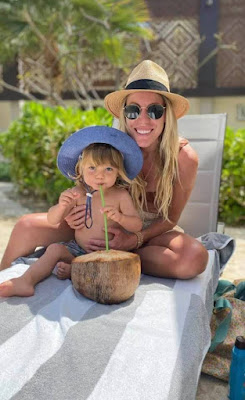Chica
stopped, her quivering wet nose pressed hard against a clump of weeds, insisting
that a straw cowlick sticking up from the swale in front of Muumuu lady’s
house, give up its information. That once blue house, now exfoliating faded
blue paint chips flaking outward, ready to be plucked, stacked, and packed in a
Pringles can of lead-based treats.
In our 16
years on this street, I had only seen her come out of the house a few times, when she put out her trash in the morning. Always
in that same Muumuu, hunched over as if to minimize her profile, a stealth land
Manatee draped in faded Hibiscus. She glides more than walks. A mystery lady,
who I later met on trash day when the dogs were taking me for a walk. Bright and friendly, a reader and
ex-schoolteacher, she was inexplicably apologetic about the status of her
anemic, weed clustered lawn. I assured her that mine was worse. Florida is not lawn friendly.
Three black
and white cats lounged comfortably in easy contortions, sunshine magnets on her
front steps. They’re so used to seeing me pull Chicca past them, blustering with
“just let me at them” bravado while conveniently restrained by her leash, that
they don’t even look up. One sits with her back to us, oblivious to Chicca’s
empty threats. It’s a cat version of giving a dog the finger. It really
pisses Chicca off.
Out on the
swale, Chicca gathered all the information she needed to identify the gender,
age, diet and general health of the last several dogs who had recently paused
at that spot, and to gulp down several sandy cat turds before I could stop
her.
Broad
patches of sand, weeds and grass under my feet, were sprinkled liberally with cones.
Cones were everywhere
in the open sand.
The entire
swale was follically challenged, covered with a grassy version of male pattern
baldness. Mostly weeds pretending to be grass really, interspersed with sandy
bald spots.
The entire
area was pockmarked like Seal’s cheeks, minus the money, models, and voice.
Cones were everywhere.
Antlions!
I smiled at
the memory of their ancestors, flourishing in the sandy dirt between the
boxwood bushes surrounding grandma’s screen porch. Instantly taken back to my
nine-year-old self, kneeling over a particularly large antlion cone, the hot
summer sun scorching my back as a million cicadas screamed in unison, drunk in
the thick humidity with their own need for love.
I was too
busy to notice, looking for a fat red ant to feed to the lion.
Now they had
followed me through 60 years, from Virginia to Florida, dying their hair blue
and looking for sandy fun in the sun., just like me.
----------------------------------------------------
Antlions are
known for the fiercely predatory habits of their larvae, which dig pits to trap
passing ants or other prey. They are sometimes referred to as doodlebugs due to
the odd winding, spiraling trails they leave in the sand while relocating. It
looks like someone has been doodling there.
They most
commonly occur in dry and sandy habitats where the larvae can easily excavate
their pits.
For these
trap-forming ambush predators, catching prey is risky because food arrives
unpredictably, so the larvae have low metabolic rates and can survive for long
periods without food.
Antlion
larva eat small arthropods – mainly ants. The larva is a voracious predator.
Within a few minutes of seizing prey with its jaws and injecting it with venom
and enzymes (think MSG and meat tenderizer), it begins to suck the juice out of
that thing as if it were a ripe Valencia recently plucked from a sweltering
Valencia grove.
When It’s
happy with the hood, an antlion larva starts to crawl backwards, using its
abdomen as a plough to shovel up the soil. Using one front leg, it places
consecutive heaps of loosened particles upon its head, then with a quick jerk,
throws each little pile clear of the cone. As it slowly moves round and round,
the pit gradually gets deeper and deeper, until the slope reaches the steepest
angle the sand can maintain, on the verge of collapse from slight disturbance and
the pit is solely lined by fine grains.
When the pit
is completed, the larva settles down at the bottom, buried in the soil with
only the jaws projecting above the surface, often in a wide-opened position on
either side of the very tip of the cone. The steep-sloped trap that guides prey
into the larva's mouth while avoiding crater avalanches is one of the simplest
and most efficient traps in the animal kingdom. The fine grain lining ensures
that the avalanches which carry prey are as large as possible. The sides of the
pit consist of loose sand, making an insecure foothold for any small insects
that inadvertently ventures over the edge. Slipping to the bottom, the prey is
immediately seized by the lurking antlion; if it attempts to scramble up the
treacherous walls of the pit, it is speedily checked in its efforts and brought
down by showers of loose sand which are thrown at it from below by the larva.
By throwing up loose sand from the bottom of the pit, the larva also undermines
the sides of the pit, causing them to collapse and bring down the prey with
them.
I no longer
care to gather around a mini coliseum to watch the sacrifice of innocents. In
my neutrality, I wish both the lions and ants a good day, as Chica and I head
for home.
Approaching
our front door, I was still hovering over an antlion cone in sandy
soil, flanked by boxwood bushes surrounding my grandmother’s screen porch on a very humid summer day, many
years ago.

















































